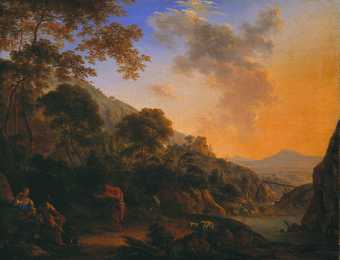
Fig.1
Henry Anderton c.1630–1665
Mountain Landscape with Dancing Shepherd
c.1650–60
Oil paint on canvas
457 x 597 mm
T03543
This painting is in oil paint on canvas measuring 457 x 597 mm (fig.1). The canvas is plain woven with 12.5 vertical threads and 15 horizontal threads per square centimetre. There are several weave faults, thickenings and ladders (fig.2). Cusping of the canvas weave is present on all edges except the lower.1 A remnant of tacking margin on this lower turnover-edge proves that the painting has not been cut down here, which might otherwise be inferred from the absence of cusping; rather it indicates that the canvas was taken from one end of a much longer piece of canvas that had been held under tension on its long edges for priming, then cut down when dry to form the support of this painting. The tacking margins are no longer present on the other edges. The stretcher is from the nineteenth century and is probably contemporary with the previous lining.
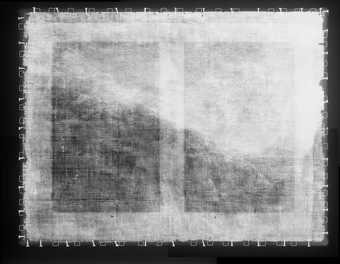
Fig.2
X-radiograph of Mountain Landscape with Dancing Shepherd
The oil-based ground is off-white, composed of lead white, chalk, ochres, Cologne earth, black and glassy particles.2 It was applied moderately thickly with a generally smooth surface, although the marks of a brush are visible in the lower right corner. Unpainted ground is visible on the remnant of tacking margin described above.
There is no evidence of preliminary drawing, nor significant underpainting, though areas of the foreground appear to have been laid in with dull tawny brown and orange paint before being worked up wet-in-wet with the colours that are visible to the viewer. Examination of the paint at the junction between the sky and the land indicates that the sky was put in first but was still wet when the landscape was painted. The sky was allowed to dry before the branches and foliage on the left were painted on top of it.
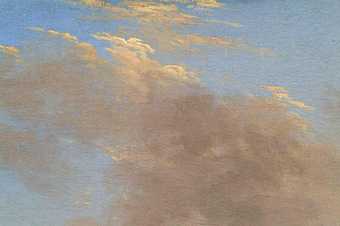
Fig.3
Macro-photograph of the clouds, showing creamy impasto
Brushmarks are visible on close examination but the surface is generally smooth with only minor areas of slight impasto, such as the highlights on the clouds (fig.3). Like the ground layer, the paint is of moderate thickness and is generally opaque and of a creamy consistency. The blue pigment in the sky is ultramarine and is also present in the mixtures for the green foliage, along with green earth, black, vermilion, ochres, lead tin yellow and lakes. Ultramarine occurs also in the blue bodice of the woman on the left; there is a layer of brick red paint beneath it. As an underpainting this colour would be unusual for ultramarine, so it may indicate that the artist changed his mind about the colour. On the other hand, the figures were painted nude before their drapery was applied, so it is possible that this artist had his own system of developing his compositions. Figs.4 and 5 show further details of the painting, including the signature.
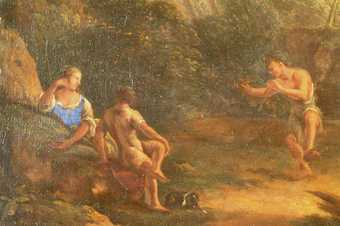
Fig.4
Macro-photograph of dancing figures
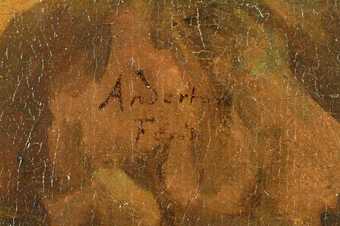
Fig.5
Micro-photograph of signature
The painting was cleaned and relined in 1984. A stamp on the stretcher indicates that the previous glue composition lining was done by G. Morrill.
December 2003
